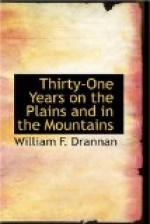On our arrival at the fort they were anxious to get us fitted out and started as soon as possible. Mr. Roubidoux said: “Last winter you made four trips for us; now every extra trip you make this winter we will give you fifty dollars extra, apiece,” which we thought a great layout.
We started out with thirty-two pack animals and the same Mexican boy as assistant that we had the previous winter.
While passing through the Comanche country we met a young man of that tribe with whom I was on good terms, having done him a favor during the war between his tribe and the Utes, for which he felt very grateful to me. After learning where we were going, he said: “Look out for the Sioux, for they have killed lots of white people this fall near Pawnee Rock.” But he did not tell us that his tribe and the Sioux were at war.
When we had passed nearly through the Comanche country we thought they were all west of us, for we saw where a large band of Indians had crossed the road going South. This we did not exactly understand, for we well knew that neither the Comanches nor Kiowas had hunt-parties out this time of year, as the buffalo were moving South, and the Indians could kill all they wanted near the villages.
It was about noon when we crossed the Indian trail and that was the general topic of conversation the balance of the day. If they had been on foot we could easily have told what tribe they belonged to by their moccasin tracks, but they all being on horseback left us to guess.
We made an early camp so that if it became necessary we could move that evening, but we built no fire.
As soon as we had decided on our camping place and while Jim and Hasa, the Mexican boy, were unpacking and arranging the camp, I rode about two miles from camp to high ground to look for Indians. When I was on the highest point I could find, I saw a little band of Indians coming from the South, and making their way for the river below us. They were about ten miles away and I could not tell by looking through my glasses just the exact number, but I could see them plain enough to tell they were not Comanches.
On my return to camp I told Jim Bridger what I had seen and he at once declared that they were Sioux, and said we were sure to have trouble with them before long.
We decided to remain there that night, and I agreed that I would stand guard while Jim and Hasa slept. I stood guard until the morning star rose, and I turned in, telling Jim to get an early breakfast and call me, which he did. The boy brought in our horses, saddled them and tied them near camp. The pack animals were also feeding near camp.
Just as we had finished our breakfast and it was getting good daylight, I cast my eyes in the direction of our horses and saw that a number of them had raised their heads and were looking off down the river as though they had seen something. I sprang to my feet and saw nine Indians coming up the river in the direction of our camp, but they were apparently sneaking along slowly. I could see at once by their movements that they did not think they were discovered yet. I said to Jim: “The Sioux are on us,” and he sprang to his feet, saying, “Let us mount our horses and meet them before they get among our pack horses,” which we did, at the same time telling Hasa to keep the horses together.




